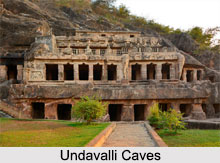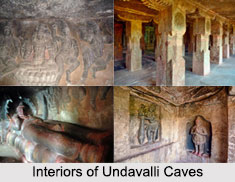 Undavalli Caves are a group of monolithic four story rock-cut caves which are the most striking and biggest monumental structures situated in the hills near Vijayawada, Andhra Pradesh. It is one of the ancient caves in Guntur. The caves are surrounded by greenery which is fed by the Krishna River. The Hindu temples in Undavalli Caves are an astonishing accomplishment of architecture and engineering. There are several murals and sculptures in the four storied rock-cut temples, which is the biggest structure in Undavalli Caves. Frescoes are present in the first floor that was created during 7th-8th century AD. The paintings, which were made in a later period, portray numerous mythological tales of the Hindu religion.
Undavalli Caves are a group of monolithic four story rock-cut caves which are the most striking and biggest monumental structures situated in the hills near Vijayawada, Andhra Pradesh. It is one of the ancient caves in Guntur. The caves are surrounded by greenery which is fed by the Krishna River. The Hindu temples in Undavalli Caves are an astonishing accomplishment of architecture and engineering. There are several murals and sculptures in the four storied rock-cut temples, which is the biggest structure in Undavalli Caves. Frescoes are present in the first floor that was created during 7th-8th century AD. The paintings, which were made in a later period, portray numerous mythological tales of the Hindu religion.
History of Undavalli Caves
Undavalli Caves are mainly related with the imperial Vishnukundina Empire that ruled over a major portion of the country during 420-620 AD. Undavalli Caves were dedicated by local governor Madhava Reddy to Ananta Padmanabha Swamy and Lord Narasimha. The Undavalli Caves had originated as Buddhist temples and monasteries as the Vishnukundina dynasty were followers of Buddhism. Initially they were utilised by Buddhist monks as dwellings. Many sculptures of Buddhist art have been preserved well. In a later period, Hindu religion dominated the caves and was converted in Hindu shrines. Artworks and sculptures related to Hindu mythology are present throughout the caves.
According to legends, a 9 km long underground tunnel exists beneath the cave that leads to Mangalgiri Mountain, which is considered sacred. It is widely believed that the entrances to the tunnel have been sealed off by authorities to avoid accidents.
 Architecture of Undavalli Caves
Architecture of Undavalli Caves
The architecture of Undavalli Caves appears to be influenced by Chalukya and Gupta architectural styles. There are numerous chambers cut in rock, other than the four storied cave, which is considered most significant. The entire four storied structure is cut out of massive sandstone precipice and the architecture resembles that of a deserted fortress. The front area is almost 29 m in width, and each consecutive floor diminishes and recedes in size. There are around 9 separate accesses to enter the first floor, which contains enormous quadrangular columns. It is evident from the architectural planning and style of the artworks that the first floor was mainly used as a vihara of Buddhist monastery. There are ancient monastery cells cut in rock in the chambers. The hallway is unfinished and consists of 8 pillars. 3 different sanctuaries with pillared lobby are also present devoted to the 3 foremost Gods in Hindu religion; Vishnu, Brahma and Shiva, known as "Trimurti".
Interiors of Undavalli Caves
The first floor is decorated with frescoes that depict mythological tales, created in 7-8th Century AD. There are also few paintings that are created in a much later period. A statuette of Lord Vishnu is present in the second floor. The 5m long figurine appears in the Padmanabha manifestation, lying in the reclining position. The statue is created of an individual granite block. The shrine is decorated with many other artworks and sculptures including an awning of Adi Shesha, Lord of Nagas (serpents). The fascia in the third floor is ornamented with several sculptures, involving figures of wild animals like elephants and lions. The walls display sculptures carved by skilled craftsmen.



















